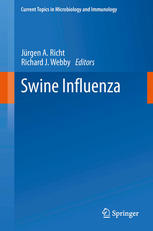Swine Influenza 2013
دانلود کتاب پزشکی آنفولانزای خوکی
| نویسنده |
Juergen Richt, Richard J. Webby |
|---|
| تعداد صفحهها |
303 |
|---|---|
| نوع فایل |
|
| حجم |
5 Mb |
| سال انتشار |
2013 |
89,000 تومان
از اولین توصیف دقیق بالینی این بیماری در غرب میانه ایالات متحده در سال 1918، تا جداسازی عامل ایجاد کننده، اولین ویروس آنفولانزا، در سال 1930 تا نقش آن در پیدایش بیماری همه گیر خوکی انسان در سال 2009، نقش اساسی در اکولوژی آنفولانزا ایفا کرد. اگرچه مخزن طبیعی اصلی ویروس های آنفولانزای A در نظر گرفته نمی شود، اما خوکی میزبان طیف محدود اما پویا از ویروس ها است. تعدادی از زیرگروه های ویروس آنفولانزای انسانی و پرندگان A، از جمله H1، H2، H3، H4، H5، H7 و H9، از جمعیت های جهانی خوکی جدا شده اند. با این حال، بسیاری از این جدایهها از نظر تعداد محدود بودند و ویروسهای آنفولانزای H1 و H3 تنها برای تشکیل سویههای پایدار در خوکها شناخته شدهاند. از این نظر، ویروسهای آنفلوانزای خوکی (SIV) مشابه همتایان خود در انسان هستند، زیرا ویروسهای H1 و H3 نیز حفظ شدهاند. ماهیت ویروس های H1 و H3 بین دو جمعیت میزبان متفاوت است و همانطور که در این کتاب بحث شد، به دلیل معرفی چندگانه ویروس آنفلوانزای مرغی و انسانی، حتی در جمعیت خوکی در مناطق مختلف جغرافیایی جهان متفاوت است.
From the first detailed clinical description of the disease in the Midwestern United States in 1918, to the isolation of the causative agent, the first of any influenza virus, in 1930 to its role in the genesis of the 2009 human pandemic, swine have played a central role in the ecology of influenza. Although not considered the major natural reservoir for influenza A viruses, swine are host to a limited but dynamic assortment of viruses. A number of subtypes of influenza A viruses of human and avian origin, including H1, H2, H3, H4, H5, H7, and H9, have been isolated from global swine populations. Most of these isolations have, however, been limited in number and it is only H1 and H3 influenza viruses that are known to have formed stable lineages in swine. In this respect, swine influenza viruses (SIV) are similar to their counterparts in humans where H1 and H3 viruses have also been maintained. The nature of these H1 and H3 viruses differ between the two host populations, however, and, as discussed throughout this book, are even different in swine populations in different geographic regions of the world due to multiple introductions of avian and human influenza viruses.




